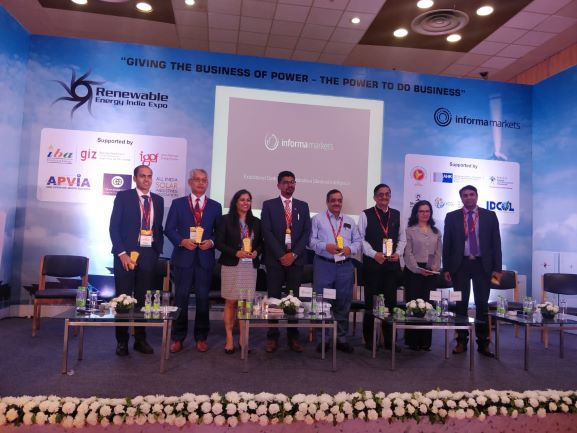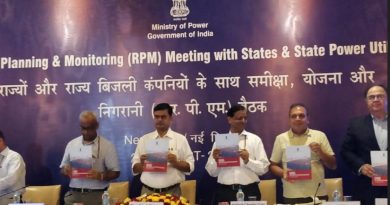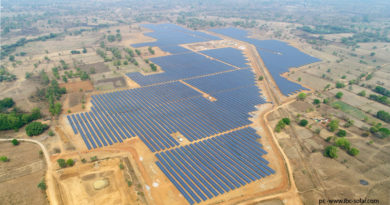REI 2019: Impact of Solar Energy in 2030
The Renewable Energy India Expo or REI 2019 held a session on the impact of solar energy which talked about the growth of solar in the energy mix of India in 2030.
 In the Picture from L to R- Rohit Gadre, Prof. Sulaiman Shaari, Monika Rathi, Tanmay Bishnoi,R. K. Jain, Shirish Garud, Poonam Sandhu and Kapil Maheshwari
In the Picture from L to R- Rohit Gadre, Prof. Sulaiman Shaari, Monika Rathi, Tanmay Bishnoi,R. K. Jain, Shirish Garud, Poonam Sandhu and Kapil Maheshwari
This session held on the first day of Renewable Energy India Expo (REI) 2019 saw experts from government and private companies discuss the future of solar after a difficult 2018-19.
The session was moderated by Tanmay Bishnoi, Associate Director, IGH – Strategy & Operations, KPMG Advisory Services and the speakers were:
- R. K. Jain, Additional General Manager, Solar Energy Corporation of India
- Kapil Maheshwari, CEO, Hinduja Renewables
- Shirish Garud, Senior Fellow and Director, TERI, New Delhi
- Poonam Sandhu, Finance Sector Specialist & India Head Consultant, NRDC
- Monika Rathi, Head Business Development – EPC India & SEA markets, Mahindra Susten
- Prof. Sulaiman Shaari, Secretary-General, Asian Photovoltaic Industry Association, Malaysia
- Rohit Gadre, Solar Analyst, Bloomberg NEF
The session kicked off with a presentation by Rohit Gadre of BNEF who presented a long term analysis of solar energy plants. “Solar will play an important role in energy till 2050,” he said. Gadre presented the performance concerns of the plants as a major worry for the solar industry.
According to the BNEF analysis of about 82 solar plants all over the country, operational data of 35 plants had comparable CUF data, on the other hand, 47 projects were found to be underperforming. “The Silver lining is that these 35 plants were constructed in 2014-15, that means these plants are performing closer to their capacity.”
He then spoke about the bankability of the new solar module technologies. The study and survey of IPPs, banks, and others showed that shingles fall behind in bankability while bifacial and half-cut is faring well in the market. BNEF study also pointed out that the wholesale market of power has turned ‘upside down’ due to solar. This means that grid operators, as well as solar projects, will have to adapt along with falling prices and reduced margins.
Kapil from Hinduja quickly pointed out that the Indian market has ‘not evolved’ to design the plants that will last at least for two decades. “We have to focus on making renewable energy available 24×7, the gaps are there but we have to move forward as India is the 3rd largest market (solar) and with this challenges will prevail,” he said. To this Rohit from BNEF interjected that the tariff in India are lowest even if they are normalized without the VGF and other incentives.
Poonam Sandhu from NRDC talked about the availability of financing but added that “we need to grow this market with the help of international institutions.” She said that “issue of bankability of the project lies in the identification and mitigation of risk for the financiers. Improving bankability depends on off-taker risk, improving the financial health of Discoms, payment security mechanism and insurance products that aim to improve the bankability of such projects.”
She further noted that there is a need for legal risk mitigation hinting at the recent row of AP government’s review of PPAs, “Legal risk mitigation has also come up. Specific insurance product like HDFC’s ERGO Solar Energy Shortfall Insurance and ICICI Lombard policy to stop power producers from going bankrupt are good examples.”
R.K. Jain of SECI elaborated on the changing role of the government and its agencies in the solar industry. “ SECI’s job was to reduce the viability gap, ensure quality and the monitoring of solar plants to ensure minimum CUF is met.” He pointed out that after 2017 when the country achieved grid parity, MNRE and SECI started to remove subsidies from commercial and industrial solar sector.
“In rooftop too the govt has removed all its subsidies. Only the residential sector for rooftop will get subsidies now,” he said. RK Jain went onto lauding the success of RESCO model for India which was introduced by SECI and remained optimistic and said that “500 GW is the target for 2030 and solar will provide 350 GW up from 100 GW in the 175 GW RE target for 2022.”
Monika from Mahindra Susten spoke about how price is putting pressure on the supply chain of solar modules. She quipped about the need for value engineering, “Value engineering is the way to meet the needs of the plants. Few ongoing trends like the drainage in O&M should not be touched, but the industry can let go of frills like bitumen roads.” On future trends, she hopes that by 2030 ‘man-less O&M plants’ will become a common sight which will only need reactive or proactive help for maintaining the new solar plants.
On a global level, she said the injection of electromobility will change the RE power systems, “Global trend will see a hybrid system for 24×7 power and electric vehicles, which will be grid-connected and will be powered by RE, especially solar.”
Talking about the future of solar energy in 2030, Shirish of TERI pointed out that there will be a significant impact on grid operation. According to him, the Indian grid handles 360 GW of installed capacity with a peak demand of 180 GW. But with more renewable energy injected in the grid, there will be a need for more flexibility due to the shift in peak timings as more solar and wind come into the picture.
He said that this extra power in the future will see ‘trading of electricity on spot markets’ and different business models for solar and hybrid systems taking shape by 2030. “2030 will be disruptive for the market of RE electricity,” he said. He is hopeful that architects too will incorporate solar and other RE forms into their design to increase its aesthetic value.
Poonam Sandhu of NRDC made an excellent point and added that the focus should also be on the development of a second-hand market for solar modules and equipment, which will further help in developing a lenders market, to assess the value of the products, after dismantling or for reenergizing older plants.




